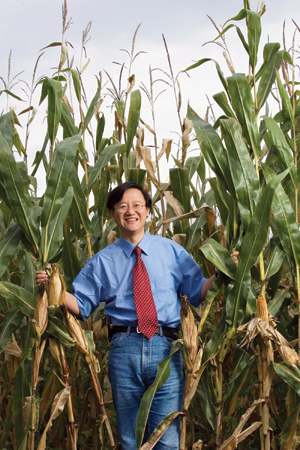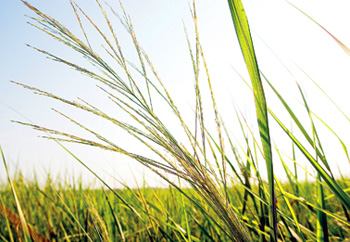 |
|

|
Hydrogen-powered cars will line the streets. Fields of switchgrass or other crops grown for energy will extend into the horizon. And farmers will turn what traditionally have been waste products into fuels. When biofuels advocates describe the future, they often speak about new technologies and innovations that will reduce U.S. reliance on oil and other nonrenewable energy sources. Joining their colleagues in higher education, government, and industry around the country, Virginia Tech scientists are making progress toward this future by probing for economical, bio-based alternatives to fossil fuels. One Virginia Tech researcher envisions using the non-grain byproducts from annual crops grown for food as a source of biomass. Y.H. Percival Zhang, assistant professor of biological systems engineering, is working to make the process of converting corn into ethanol more economical by finding ways to convert the non-grain parts of the crop into biofuel. "Utilization of non-food biomass for biofuels and bio-based production means great opportunities for a clean and sustainable economy," Zhang says. Zhang believes that he can cut costs and increase revenue and yield by converting the plant's leaves, stalks, and cobs into ethanol and using the kernels as food. Many technologies have already been developed to turn these materials into sugars, but costs are high and yields low. In response, Zhang has developed a pretreatment process that overcomes these limitations by using a strong cellulose solvent to free the sugars instead of the highly corrosive chemicals, high pressure, and high temperature typically needed to produce such biofuels as ethanol or hydrogen. Using synthetic biology approaches, Zhang and his colleagues from Oak Ridge National Laboratory and the University of Georgia demonstrated that a combination of 13 enzymes never found together in nature is able to convert certain types of sugars into hydrogen. Biométhodes, a French biotechnology company, has recently signed an exclusive and worldwide option-to-license agreement to use this technology. This is the first step toward building an integrated biorefinery pilot plant in Virginia to advance this process. Zhang says a 100-ton per day biorefinery will produce an estimated three million gallons of ethanol and valuable co-products each year. Because of the efficiency of Zhang's process and the cost saved by selling the co-products, the ethanol production costs would be about $1 to $1.20 per gallon.A closer look at switchgrass Although food-crop residue has the potential to produce a considerable amount of biomass for fuel, much of the research at Virginia Tech and around the world is on alternative sources of biomass, such as switchgrass. "We are asking ourselves, 'If Virginia agriculture is interested in getting into the energy business, what species should we use and how highly well-suited are they?'" says David Parrish, professor of crop and soil environmental sciences. Several Virginia Tech projects are comparing switchgrass, commonly used as a benchmark species, to other possible biomass sources. Researchers have funding from the Virginia Agriculture Council and the Powell River Project to compare feedstock species at several locations throughout the state, including on reclaimed mine land. Benjamin Tracy and John Fike, both associate professors of crop and soil environmental sciences, are joining Parrish in another Virginia Agriculture Council-funded project to explore the productivity of switchgrass grown alone or with other native plants. Additionally, a new five-year grant from the U.S. Department of Energy will look at switchgrass productivity under different management types in the field. Under the supervision of John Galbraith, associate professor of crop and soil environmental sciences, researchers are also investigating the potential of these crops to sequester carbon in the soils, a process that not only improves soil quality but also cuts down on greenhouse gases in the atmosphere. Although switchgrass is widely considered a good possibility as an alternative feedstock for biofuels, Virginia Tech researchers are still trying to determine whether the dramatic yields reported on research plots are possible when the species is planted and managed on a large scale. John Cundiff, professor of biological systems engineering, is looking at the logistics of managing and transporting this alternative crop.
Although much of Virginia Tech's switchgrass research has focused on traditional questions of agronomy, some of it includes the application of biotechnology and genomics. Assistant Professor of Horticulture Bingyu Zhao is using these new tools to improve the crop's biomass production and resistance to biological, environmental, and other stresses. Virginia Cooperative Extension has also surveyed producers to determine whether they have an interest in growing switchgrass. "Virginians are interested in seeing how we can create new markets for agricultural products and become less dependent on foreign sources of oil," says John Ignosh, an agricultural byproducts utilization specialist for Extension's Northwest District. "Developing a bioenergy industry in rural Virginia could serve as a means to reach both of these goals while fostering rural economic development." Likewise, Jeff Waldon, executive director of the Conservation Management Institute at Virginia Tech, has been investigating the possibility of paying Virginian farmers for switchgrass that could be burned in the same combustion unit as coal to generate electricity, a process known as co-firing. "If this new co-firing idea takes hold, a large, new, stable market for an agricultural crop could change the landscape of farming," Waldon says. "With the reduction in tobacco acreage, and the instability of other crops, farm profitability has been declining for some time. A new crop that is locally grown and utilized would help farmers and rural communities in Southside." Fuel from an unexpected source Woody plants, another possible feedstock for biofuels, have also been the focus of Virginia Tech research. Associate Professor of Horticulture Eric Beers is leading a study on the protein-protein interactions associated with biomass production in poplar wood, research that has attracted $1.2 million from the U.S. Department of Energy and U.S. Department of Agriculture. This work focuses on all the species and hybrids in the genus Populus, which includes aspens and cottonwoods but not the yellow tulip tree commonly called "poplar." "Poplar is a model biomass crop," Beers explains. "If we can identify the protein-protein interaction networks associated with its woody tissues, it will give us a more detailed understanding of the molecular biology of biomass production." Researchers know little about how proteins, the molecular machines needed to create plant cell walls, interact with each other during wood formation. Amy Brunner, associate professor of forestry, and Allan Dickerman, assistant professor at the Virginia Bioinformatics Institute, are incorporating expertise on poplar genomics and using advanced technologies of computational biology, respectively, to map these protein-protein interactions. The use of wood as a model biomass crop is not limited to the realm of basic science, though. John Munsell, assistant professor of forestry and forest-management Extension specialist, has been holding public interest meetings in Virginia to gather citizen input and coordinating training for state agency and Extension personnel on this possible solution to the nation's energy problem. "Improving the utilization of woody biomass from both rural forests and urban landscapes is a promising arena in the pursuit of a viable alternative to fossil fuels," Munsell says. Reusing nature's resources Another Virginia Tech researcher is helping poultry growers in the Shenandoah Valley turn organic resources from animal agriculture into biofuels and other chemicals. Foster Agblevor, associate professor of biological systems engineering, has developed a transportable pyrolysis unit that converts poultry litter into bio-oil, producer gas, and fertilizer. "Our pyrolysis unit heats the litter until it turns into a vapor, which can then be condensed into the bio-oil," Agblevor explains. This process also allows farmers to use the bio-oil as an alternative fuel source or sell it for increased agricultural profits. An added benefit is that it has the potential to remove phosphorus and nitrogen pollution from the Shenandoah Valley, a part of the Chesapeake Bay Watershed. Agblevor is working on a variety of research projects that relate to biochemical and thermochemical conversion of biomass, including cotton-gin waste and switchgrass, to fuels and other chemicals. He recently received funding from the Virginia Tobacco Indemnification and Revitalization Commission to develop an advanced form of pyrolysis to convert switchgrass into green diesel. Throughout all of their research and outreach, Virginia Tech faculty members keep the country's energy crisis in the back of their minds. According to the most recent figures from the U.S. Department of Energy, fossil fuels like coal, natural gas, and petroleum still make up more than 85 percent of U.S. energy consumption, while renewable energy sources like biomass and geothermal power constitute less than 7 percent of the nation's energy use, a thin slice of the pie. By seeking innovative ways to convert the non-grain portion of traditional crops such as corn into ethanol and other fuels, investigating new possibilities such as switchgrass or poplar as biomass feedstock, and showing farmers how to turn agricultural byproducts into an energy source, Virginia Tech is responding to the national call for a future where biofuels and other renewable energy resources shape everyday lives.
|
||||||||||||||||||||||||||

